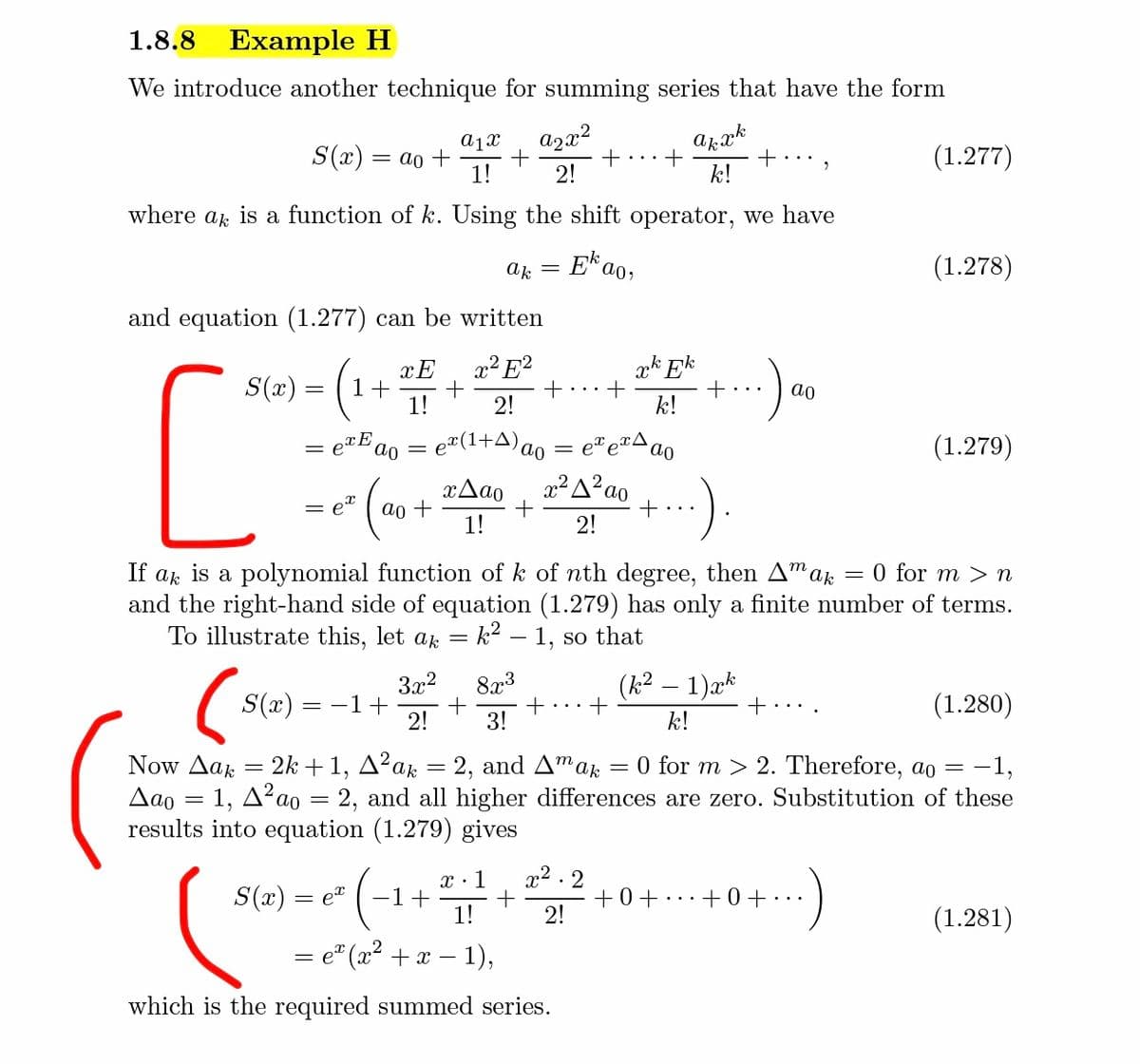1.8.8 Example H We introduce another technique for summing series that have the form S(x) = ao + a1x + 2! +...+ k! (1.277) 1! where ak is a function of k. Using the shift operator, we have ak = E*ao, (1.278) and equation (1.277) can be written ak Ek S(x) = 1+ 1! +...+ 2! ao ... k! erE ao = e#(1+A)a. (1.279) ao + 1! 2! If ak is a polynomial function of k of nth degree, then A" ak and the right-hand side of equation (1.279) has only a finite number of terms. To illustrate this, let ak = k? – 1, so that = 0 for m > n 3x2 8x3 + 2! (k2 – 1)ak S(x) = -1+ +.... (1.280) 3! k! Now Aak = 2k +1, A²ak = 2, and Amak Aao = 1, A?ao = 2, and all higher differences are zero. Substitution of these results into equation (1.279) gives = 0 for m > 2. Therefore, ao = -1, p2.2
1.8.8 Example H We introduce another technique for summing series that have the form S(x) = ao + a1x + 2! +...+ k! (1.277) 1! where ak is a function of k. Using the shift operator, we have ak = E*ao, (1.278) and equation (1.277) can be written ak Ek S(x) = 1+ 1! +...+ 2! ao ... k! erE ao = e#(1+A)a. (1.279) ao + 1! 2! If ak is a polynomial function of k of nth degree, then A" ak and the right-hand side of equation (1.279) has only a finite number of terms. To illustrate this, let ak = k? – 1, so that = 0 for m > n 3x2 8x3 + 2! (k2 – 1)ak S(x) = -1+ +.... (1.280) 3! k! Now Aak = 2k +1, A²ak = 2, and Amak Aao = 1, A?ao = 2, and all higher differences are zero. Substitution of these results into equation (1.279) gives = 0 for m > 2. Therefore, ao = -1, p2.2
Algebra & Trigonometry with Analytic Geometry
13th Edition
ISBN:9781133382119
Author:Swokowski
Publisher:Swokowski
Chapter10: Sequences, Series, And Probability
Section10.2: Arithmetic Sequences
Problem 68E
Related questions
Concept explainers
Contingency Table
A contingency table can be defined as the visual representation of the relationship between two or more categorical variables that can be evaluated and registered. It is a categorical version of the scatterplot, which is used to investigate the linear relationship between two variables. A contingency table is indeed a type of frequency distribution table that displays two variables at the same time.
Binomial Distribution
Binomial is an algebraic expression of the sum or the difference of two terms. Before knowing about binomial distribution, we must know about the binomial theorem.
Topic Video
Question
Explain the determaine

Transcribed Image Text:1.8.8
Example H
We introduce another technique for summing series that have the form
a1x
S(x) = ao +
1!
azx²
+
2!
arak
+ ,
k!
(1.277)
where ak is a function of k. Using the shift operator, we have
ak
E*a
(1.278)
and equation (1.277) can be written
x² E?
+
2!
ak Ek
S(x) =
1+
1!
ao
k!
= e#(1+A)ao
(1.279)
x2 A? ao
+
:)
xAao
ao +
1!
2!
If ak is a polynomial function of k of nth degree, then A"ar
and the right-hand side of equation (1.279) has only a finite number of terms.
To illustrate this, let a
0 for m > n
k? – 1, so that
3x2
8x3
+
2!
(k2.
1)æk
S(x) =
= -1+
(1.280)
3!
k!
Now Aa = 2k+1, A²ak = 2, and Amar
Aao = 1, A²ao = 2, and all higher differences are zero. Substitution of these
results into equation (1.279) gives
O for m > 2. Therefore, ao =
-1,
x:1
x2 . 2
S(x) =
-1+
1!
+0+..+0+
2!
et
•.
(1.281)
= e" (x2 + x – 1),
which is the required summed series.
Expert Solution
This question has been solved!
Explore an expertly crafted, step-by-step solution for a thorough understanding of key concepts.
Step by step
Solved in 3 steps with 3 images

Knowledge Booster
Learn more about
Need a deep-dive on the concept behind this application? Look no further. Learn more about this topic, advanced-math and related others by exploring similar questions and additional content below.Recommended textbooks for you

Algebra & Trigonometry with Analytic Geometry
Algebra
ISBN:
9781133382119
Author:
Swokowski
Publisher:
Cengage

Algebra & Trigonometry with Analytic Geometry
Algebra
ISBN:
9781133382119
Author:
Swokowski
Publisher:
Cengage